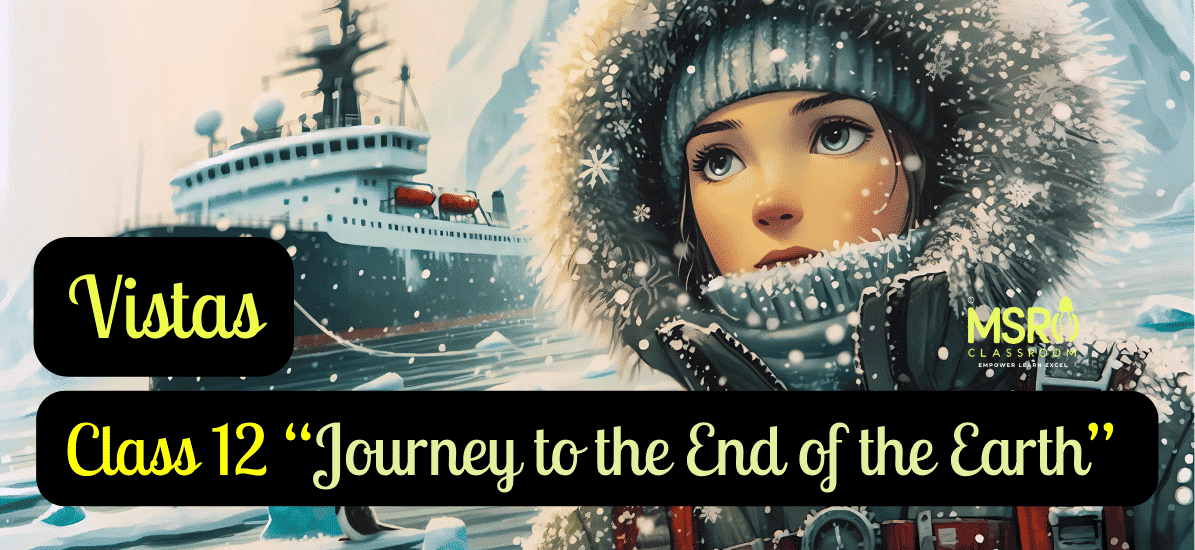Vistas, Chapter 3—Tishani Doshi’s “Journey to the End of the Earth” Summary, Theme, Question Answers, and Character Sketch.
Chapter 3- ‘Journey to the End of the Earth’ Summary & Analysis
Table of Contents
Next on Vistas: “The Enemy” by Pearl S. Buck
Summary ‘Journey to the End of the Earth’:
In ‘Journey to the End of the Earth’ by Tishani Doshi, the author recounts her expedition to Antarctica aboard the Akademik Shokalskiy, reflecting on the continent’s geological history, human impact, and environmental significance. She marvels at Antarctica’s pristine yet fragile ecosystem, emphasising the urgency of addressing climate change.
Through her experiences with Students on Ice, she highlights the importance of educating future generations about environmental stewardship. The journey contemplates humanity’s role in preserving the planet’s balance and the uncertain future of Antarctica. Doshi’s narrative highlights the interconnectedness of Earth’s systems and the need for collective action to safeguard its future.

SHOP: MSRO SMART NOTES: Class 12 English Literature
Theme ‘Journey to the End of the Earth’:
The theme of “Journey To The End Of The Earth” by Tishani Doshi encompasses exploration, environmental consciousness, and the interconnectedness of humanity with the natural world.
- Exploration and Adventure: The excerpt centres around the author’s expedition to Antarctica, one of Earth’s most remote and inhospitable places. Through vivid descriptions and personal reflections, Doshi captures the awe and wonder of exploring unknown territories and encountering the pristine beauty of Antarctica’s landscape.
- Environmental Awareness and Conservation: Doshi highlights the fragility of Antarctica’s ecosystem and the urgent need for ecological conservation. She discusses the impact of human activities, such as climate change and pollution, on this remote continent and emphasises the importance of preserving its pristine environment for future generations.
- Intricate Balance of Nature: The story highlights the interconnectedness of all living beings and ecosystems on Earth. Doshi reflects on the complex balance of nature and how changes in one part of the world can have far-reaching effects on others. Through her experiences in Antarctica, she encourages readers to appreciate life’s interconnected web and take responsibility for protecting the planet’s biodiversity and natural resources.
- Humanity’s Relationship with Nature: The narrative prompts readers to reflect on humanity’s relationship with the natural world and the impact of our actions on the environment. Doshi emphasises the need for greater environmental stewardship and sustainable practices to mitigate the adverse effects of human-induced climate change and preserve the Earth’s natural beauty and diversity.
Explanation of ‘Journey to the End of the Earth’ for Auditory Learners:
Duration: 7 Minutes
Chapters/time stamps with subtitles are available.
Character Sketch:
The Narrator/ Tishani Doshi:
The narrator of “Journey To The End Of The Earth” by Tishani Doshi is a reflective and introspective individual who embarks on a transformative journey to Antarctica.
- Curious and Adventurous: The narrator demonstrates a sense of curiosity and adventure by embarking on an expedition to Antarctica, one of Earth’s most remote and inhospitable places. This willingness to explore new territories reflects a spirit of adventure and a desire for discovery.
- Environmentally Conscious: Throughout the narrative, the narrator is deeply concerned about environmental conservation and sustainability. She reflects on Antarctica’s fragile ecosystem and emphasises preserving its pristine environment for future generations. This ecological consciousness highlights her commitment to raising awareness about the impacts of climate change and human activities on the planet.
- Reflective and Observant: The narrator is introspective and thoughtful, often pausing to contemplate the significance of her experiences and observations in Antarctica. She shares insights about the interconnectedness of life on Earth, the beauty of nature, and the urgency of addressing environmental challenges. Her observations and reflections invite readers to ponder their relationship with the natural world and consider their actions’ impact on the environment.
- Empathetic and Compassionate: The narrator demonstrates empathy and compassion for the students participating in the Students on Ice program and for the natural world. She recognises the importance of fostering a sense of stewardship and responsibility for the planet among future generations and acknowledges the profound interconnectedness between humanity and the environment.
Question Answers “Journey to the End of the Earth”:
Read and Find Out:
Q1: How do geological phenomena help us to know about the history of humankind?
A1: Geological phenomena provide crucial insights into the history of humankind through various means:
- Fossil records: Geological formations preserve fossils of ancient organisms, helping scientists understand the evolution and development of life on Earth, including early human ancestors.
- Stratigraphy: Layers of sedimentary rock and soil reveal a chronological sequence of events, allowing scientists to reconstruct past environments, climate changes, and geological events that influenced human evolution and migration patterns.
- Tectonic activity: Geological processes such as plate tectonics shape the Earth’s surface over millions of years, impacting landforms, habitats, and the distribution of resources that have influenced human civilisations.
- Mineral and resource exploitation: Geological formations contain valuable minerals and resources humans have exploited throughout history, driving technological advancements, economic development, and societal changes.
Studying geological phenomena provides valuable clues about the Earth’s history and its interactions with humankind. It aids in our understanding of past civilisations and informs future decisions and developments.
Q2: What are the indications for the future of humankind?
A2: The indications for the future of humankind are multifaceted and influenced by various factors, including:
- Environmental sustainability: Addressing climate change, biodiversity loss, pollution, and resource depletion is critical for ensuring a sustainable future for humankind and the planet.
- Technological advancements: Innovations in technology, such as renewable energy, artificial intelligence, and biotechnology, offer opportunities to address global challenges, improve living standards, and enhance human well-being.
- Socioeconomic disparities: Addressing inequality, poverty, access to education, healthcare, and economic opportunities is essential for creating inclusive and equitable societies and ensuring a prosperous future for all.
- Global cooperation: Collaborative efforts among nations, organisations, and individuals are necessary to tackle shared challenges, promote peace, resolve conflicts, and build resilient communities in the face of emerging threats and crises.
While humankind’s future is uncertain and subject to various challenges and opportunities, proactive measures, informed decisions, and collective actions are essential for shaping a positive and sustainable future for future generations.
Reading with Insight
Q1: ‘The world’s geological history is trapped in Antarctica.’ How is the study of this region useful to us?
A1: The study of Antarctica is helpful to us because:
- Antarctica preserves a wealth of geological data, including ice cores containing atmospheric gases and climate records that provide insights into Earth’s past climates and environmental changes.
- By analysing Antarctic ice cores, scientists can study past climate variations, understand the causes of climate change, and predict future climate trends.
- Antarctica’s unique geological features, such as its continental drift, glacial formations, and fossil records, offer valuable information about Earth’s geological history, evolution, and biodiversity.
- Studying Antarctica helps scientists understand global environmental processes, such as ocean circulation patterns, sea-level rise, and the dynamics of polar ecosystems, which are crucial for addressing contemporary environmental challenges and informing sustainable management practices.
Q2: What are Geoff Green’s reasons for including high school students in the Students on Ice expedition?
A2: Geoff Green includes high school students in the Students on Ice expedition for several reasons:
- The goal is to provide young people with firsthand experiential learning opportunities in polar environments, fostering a deeper understanding and appreciation for Earth’s natural systems, biodiversity, and cultural diversity.
- To inspire future leaders, educators, and environmental stewards by exposing them to interdisciplinary learning experiences, scientific research, and cultural exchanges with indigenous communities.
- To empower students to become advocates for environmental conservation, climate action, and social justice, equipping them with knowledge, skills, and perspectives to address global challenges and contribute to positive change in their communities and beyond.
Q3: ‘Take care of the small things and the big things will take care of themselves.’ What is the relevance of this statement in the context of the Antarctic environment?
A3: The statement “Take care of the small things, and the big things will take care of themselves” is relevant in the context of the Antarctic environment because:
- Despite their simplicity and lack of biodiversity, Antarctica’s ecosystems play crucial roles in global environmental processes, such as carbon cycling, nutrient recycling, and maintaining ecological balance.
- Although seemingly insignificant, small organisms like phytoplankton form the foundation of Antarctic food webs and support the entire marine ecosystem.
- By prioritising the conservation and protection of tiny organisms and delicate ecosystems in Antarctica, humans can help preserve the health and stability of polar environments and mitigate the impacts of climate change on Antarctic biodiversity and ecosystems.
Q4: Why is Antarctica the place to go to, to understand the earth’s present, past and future?
A4: Antarctica is the place to go to understand the earth’s present, past, and future because:
- Its pristine environment and remoteness from human civilisation make it an ideal laboratory for studying natural processes, environmental changes, and climate dynamics with minimal human interference.
- Antarctica’s ice cores contain invaluable records of Earth’s past climates, atmospheric conditions, and environmental changes spanning hundreds of thousands of years. These records provide insights into past climate variations, natural disasters, and geological events.
- Scientists can better understand climate change drivers and impacts by studying Antarctica’s geological features, ice sheets, and ecosystems, predicting future environmental trends, and developing strategies for mitigating global ecological challenges.
- Antarctica serves as a critical indicator of global environmental health and resilience, highlighting the interconnectedness of Earth’s systems and the urgent need for international cooperation, scientific research, and sustainable management practices to address contemporary environmental issues and ensure the long-term viability of our planet.

SHOP: MSRO SMART NOTES: Class 12 English Literature
Extra Questions “Journey to the End of the Earth”:
Short Answer Type Questions:
Q1: What sparked the author’s wonder upon arriving in Antarctica?
A1: Upon setting foot on Antarctica, the author was profoundly amazed at its vastness, isolation, and historical connection to India. He contemplated the ancient supercontinent of Gondwana and its separation into present-day continents.
Q2: How does the author highlight the significance of Antarctica in Earth’s geological history?
A2: Antarctica is a living record of Earth’s geological past, holding clues to continental drift, climate change, and evolution. It embodies the immense timescales and processes that have shaped our planet over millions of years.
Q3: What concerns does the author express regarding human impact on the environment, particularly in Antarctica?
A3: The author laments humanity’s short-term presence compared to Earth’s geological history, noting the rapid degradation caused by population growth, resource depletion, and climate change. Antarctica’s pristine state highlights the urgency of environmental conservation efforts.
Q4: What educational initiative does the author participate in, and why is it significant?
A4: The author collaborates with “Students on Ice,” a program to educate young minds about environmental conservation by exposing them to Antarctica’s pristine ecosystem. It offers transformative experiences for future leaders to understand and address global challenges.
Q5: Why does the author emphasise studying Antarctica’s ecosystem?
A5: Antarctica’s simple yet fragile ecosystem exemplifies how small changes can trigger significant consequences. Scientists can understand broader implications for global climate and biodiversity by studying phytoplankton activity and ice melting.
Q6: Describe the author’s revelatory experience walking on the ocean near Tadpole Island.
A6: The author and fellow passengers walked on a thick ice pack, realising they were walking on a living, breathing ocean. The sight of seals on ice floes highlighted the interconnectedness of all life and the delicate balance of ecosystems.
Q7: What contemplations does the author leave the reader with regarding Antarctica’s future?
A7: The author ponders whether Antarctica will return to its warmer past and the fate of humanity in the face of environmental challenges. Despite uncertainties, the author finds hope in the idealism of youth and the potential for positive change.
Q8: How does the author convey the fragility of Earth’s ecosystems through the lens of Antarctica?
A8: Doshi portrays Antarctica as a pristine yet delicate environment where even minor disturbances can have far-reaching consequences. She highlights the interconnectedness of ecosystems, highlighting how changes in one area, such as phytoplankton activity, can disrupt entire food chains and the global carbon cycle.
Q9: In what ways does the author underscore the urgency of addressing climate change and environmental degradation?
A9: Doshi vividly describes retreating glaciers and collapsing ice shelves to paint a stark picture of climate change’s immediate and tangible impacts. She emphasises Antarctica’s role as a barometer for global environmental health. She warns that losing its ice cores and unique ecosystems could irreversibly alter the planet’s climate and biodiversity.
Q10: How does the author challenge readers to confront their role in environmental stewardship?
A10: By highlighting humanity’s short tenure on Earth’s geological timeline, Doshi prompts readers to reflect on their responsibility to safeguard the planet for future generations. She urges individuals to transcend apathy and take meaningful action to mitigate the effects of climate change and preserve Earth’s natural wonders.
Long Answer Type Questions:
Q1: How does the author describe the initial emotions upon setting foot on Antarctica?
A1: Upon setting foot on Antarctica, the author describes experiencing relief and profound wonder. Having travelled for over 100 hours across various modes of transportation, including a car, an aeroplane, and a ship, the author’s primary emotion is relief. However, this feeling is quickly followed by a profound sense of wonder upon encountering Antarctica’s expansive white landscape and uninterrupted blue horizon.
The continent’s immensity and isolation strike the author. They reflect on its historical connection to India and marvel at the significant geological changes over millions of years. This initial encounter with Antarctica prompts the author to reflect on humanity’s place within the Earth’s geological history and the potential implications for the planet’s future.
Q2: What historical information does the author provide about the connection between India and Antarctica?
A2: The author provides historical information about the connection between India and Antarctica by referencing the existence of a giant southern supercontinent called Gondwana approximately 650 million years ago. Gondwana, centred around present-day Antarctica, hosted diverse flora and fauna in a warmer climate. Over time, around the era of dinosaur extinction, Gondwana separated into different land masses, shaping the globe as known today.
The author marvels that India and Antarctica were once part of the same landmass within Gondwana. This historical context highlights the dynamic geological changes that have occurred over millions of years, shaping the Earth’s continents and ecosystems and providing insight into the planet’s evolutionary history.
Q3: In what ways does the author illustrate the impact of human civilisation on the environment, particularly regarding climate change?
A3: The author illustrates the impact of human civilisation on the environment, particularly regarding climate change, by highlighting several key factors. Firstly, the author points out that human society, despite its relatively short existence of 12,000 years, has rapidly transformed the planet’s landscape through urbanisation and industrialisation. Burning fossil fuels has led to the accumulation of carbon dioxide in the atmosphere, contributing to the greenhouse effect and global warming.
This has resulted in various environmental issues, including melting polar ice caps and disruptions to ocean currents. By discussing these consequences, the author emphasises the urgent need for action to mitigate human-induced climate change and its potentially catastrophic effects on the planet’s ecosystems and biodiversity.
Q4: What role does Antarctica play in the ongoing debate about climate change, according to the author?
A4: Antarctica plays a crucial role in the ongoing discussion of climate change, according to the author, for several reasons. Firstly, Antarctica remains relatively “pristine” due to its lack of a permanent human population, making it an important reference point for understanding pre-industrial environmental conditions. Additionally, Antarctica’s ice cores contain half-million-year-old carbon records, providing valuable data for studying Earth’s past climates and informing predictions about future climate trends.
Furthermore, the continent’s vulnerability to climate change, evidenced by visible phenomena such as glacier retreat and ice shelf collapse, is a powerful reminder of the urgent need for global action to mitigate its impacts. Antarctica thus serves as a laboratory for scientific research and a stark warning of the consequences of human-induced environmental change.
Q5: How does the program “Students on Ice” aim to contribute to the understanding and preservation of the planet?
A5: The program “Students on Ice” aims to contribute to the understanding and preservation of the planet through several key initiatives:
- Educational Opportunities: The program provides high school students inspiring educational opportunities by taking them to remote and environmentally significant locations, such as Antarctica.
- Fostering Understanding and Respect: The program immerses students in these environments, promoting a new understanding and respect for the Earth and its ecosystems.
- Encouraging Action: “Students on Ice” aims to empower the next generation of policy-makers and environmental advocates by instilling a sense of responsibility and agency to address pressing environmental issues.
- Experiential Learning: Students gain practical knowledge of environmental conservation and sustainability through hands-on experiences and interactions with scientists and experts.
- Raising Awareness: The program raises awareness about the importance of preserving pristine environments like Antarctica and highlights the interconnectedness of global ecosystems.
“Students on Ice” seeks to inspire young leaders to become stewards of the planet and champions for environmental conservation.
Q6: What significance does the author attribute to Antarctica’s ecosystem and biodiversity about global environmental health?
A6: The author attributes significant importance to Antarctica’s ecosystem and biodiversity to global environmental health. Despite its seemingly simple ecosystem and limited biodiversity, Antarctica plays a critical role in maintaining the balance of global ecosystems. The continent’s unique environment, from its microscopic phytoplankton to its marine animals and birds, supports the Southern Ocean’s delicate food chain and regulates the global carbon cycle.
The author emphasises that even small changes in Antarctica’s environment, such as the depletion of the ozone layer, can have far-reaching repercussions on marine life and global climate patterns. Therefore, preserving Antarctica’s ecosystem is crucial for maintaining the health and stability of the entire planet’s environment.
*****




